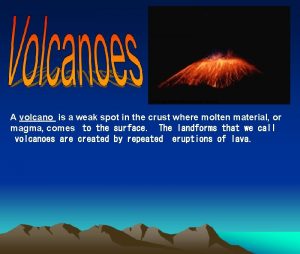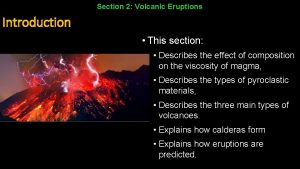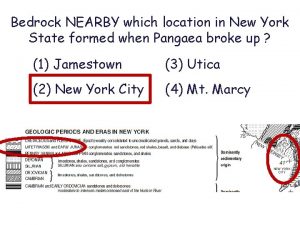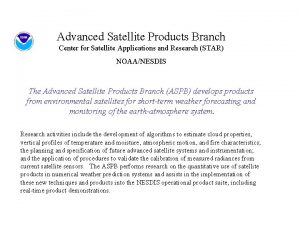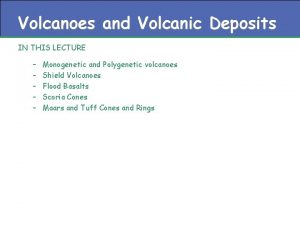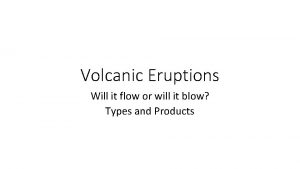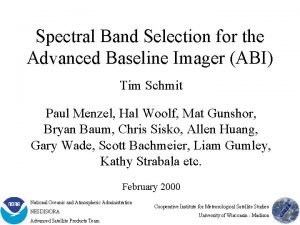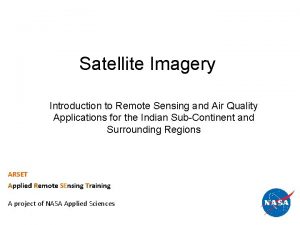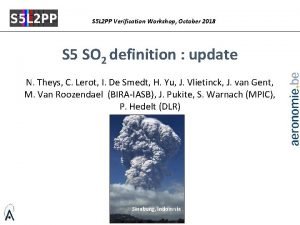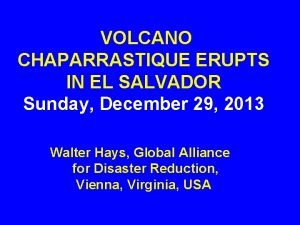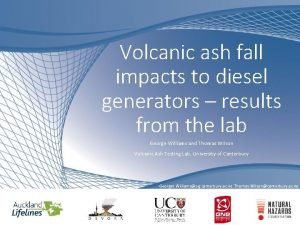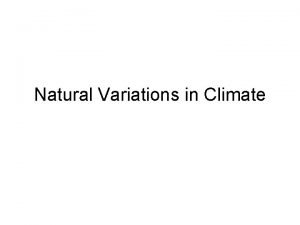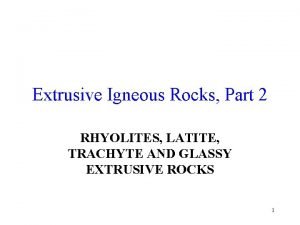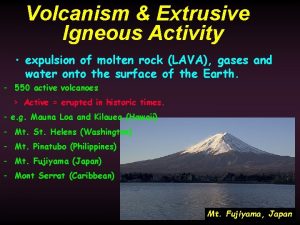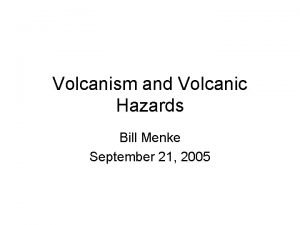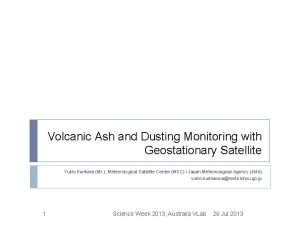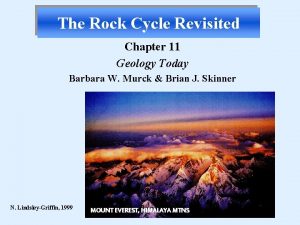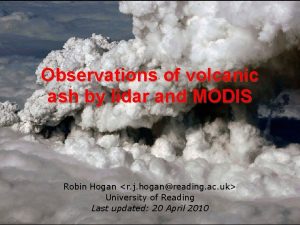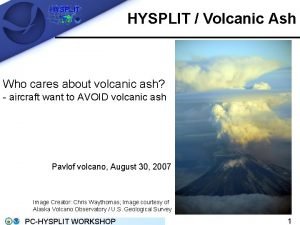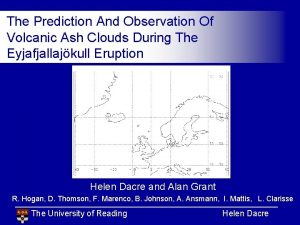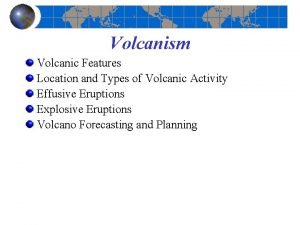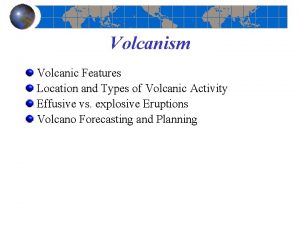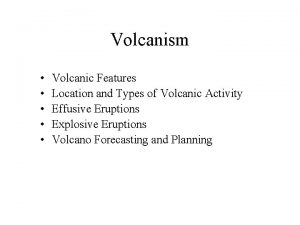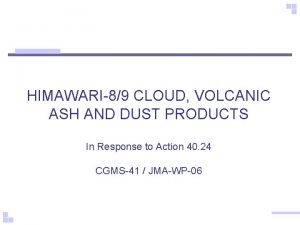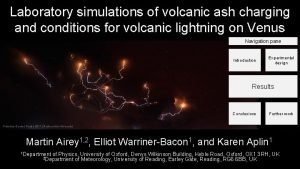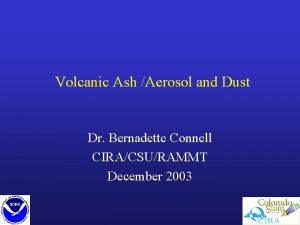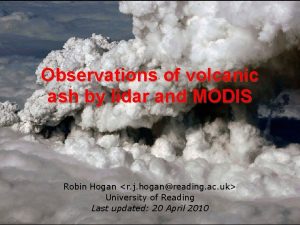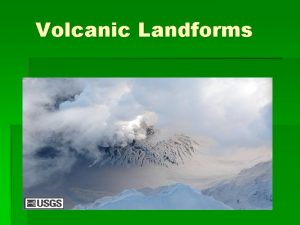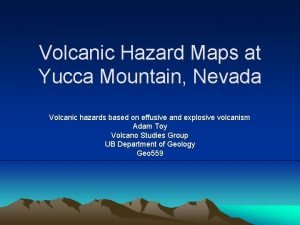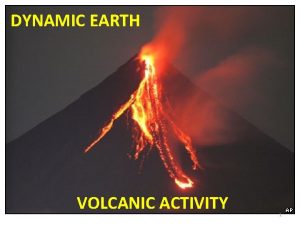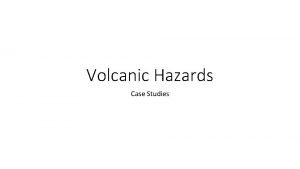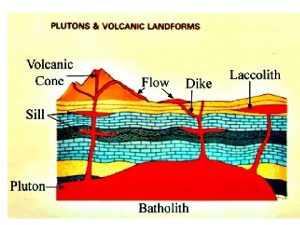Volcanic Ash Detection and Prediction at the Met





















- Slides: 21

Volcanic Ash Detection and Prediction at the Met Office Helen Champion, Sarah Watkin Derrick Ryall • Responsibilities • Tools • Etna 2002 • Future 08/2003 1

Met Office is the London VAAC = Volcanic Ash Advisory Centre 08/2003 2

Satellite ash detection products n AVHRR – ch 4 (10. 8 m) - ch 5 (12. 0 m) – available within 30 mins n Covers three areas: – Mediterranean area (Mt. Etna) – London VAAC – Iceland n Frequency – 3 hourly over Iceland – 6 hourly over the Mediterranean 08/2003 3 28 October 2002 1316 UTC

AVHRR London VAAC (ch 4 -ch 5) 08/2003 4

Met Office NAME model n Dispersion model – Predicts the transport of airborne pollutants – 1 -1000’s km, hours - days – Lagrangian particle model n Emergency response – nuclear, volcano, fire, FMD n Air pollution – episodes, forecasts, chemistry n Source attribution – where, when, how much – source/receptor relationships – CTBTO 08/2003 5

Volcanic Ash Graphics n Three levels – FL 350 -FL 550 – FL 200 -FL 350 – Surface-FL 200 n Source – Unit release – between summit height and plume top – assumes particle size distribution n T+6, 12, 18, 24 n Extent of ‘visible’ ash cloud 08/2003 6

Additional Volcanic Ash graphics n Contoured plumes n Six levels n Easier comparisons with imagery / observations 08/2003 7

Recent Improvements to NAME n Automated plotting threshold for visual ash cloud concentrations – Previously manual forecaster input based on obs n Upgraded to use ‘New Dynamics’ version of Unified Model – 3 hourly global fields to T+144, ~60 km resolution – Increased vertical resolution (particularly near tropopause) n 08/2003 8 Revised boundary layer turbulence schemes

Volcanic Ash - Trajectories 08/2003 n Also provide trajectories n Follow mean wind n Start at several levels n Quick indication of plume spread at various levels 9

Iceland Daily runs n Improve response times and preparedness n Daily simulations using NAME n Release from Katla – 6 hour release – 0, 6, 12 & 18 Z – surface to FL 400 n 08/2003 Output on six levels 10

Etna eruption 2002 n 27 Oct 2002 Etna erupted to ~FL 200 n Emissions continued over several days n Useful case to look at – Full range of satellite imagery – Area largely cloud free 08/2003 n Use NAME to simulate first 10 days of emissions n Continuous release from surface to FL 200 n Compare concentrations (FL 100 & FL 200) with satellite imagery, particularly ch 4 -ch 5 11

Etna 28/10/2002 08/2003 12

Etna 29/10/2002 08/2003 13

Etna 30/10/2002 08/2003 14

Etna 31/10/2002 08/2003 15

Etna 29/10/2002 Coloured by height (yellow=low level, red = high level) 08/2003 16

Effect of poorly resolved volcano Model Actual Inversion Peak not resolved Inversion below summit Inversion above ‘model’ summit Plume remains in free troposphere Plume also in boundary layer 08/2003 17

Poorly resolved orography 08/2003 n Particular problem with isolated peaks n No simple solution as NWP data will not properly represent flow around/over peak n If use ‘model’ summit height column is ‘stretched’ - material spreads over twice the height, giving lower concentrations n Suggest using ‘elevated’ source 18

Impact of poorly resolved orography Release surface to FL 200 08/2003 19 Release FL 100 to FL 200

Future Work n Volcanic ash detection – SEVERI on MSG (including AVHRR ch 4 -ch 5) – 15 minute imagery n Automatic detection system (Helen Watkin’s talk) – Upgrade to MSG – Operational implementation n Modelling – Need better definition of ‘Visual Ash Cloud’ - more appropriate would be ’concentrations hazardous to aviation’ – Include sulphur as well as ash – Ensemble approach - multiple NAME runs on ECMWF EPS members (51) 08/2003 20

Summary n Volcanic ash detection system and NAME predictions give increased confidence in operational VAAC results n Etna case study demonstrates the value of these tools n Issues for future work include – calibration of satellite imagery – representation of orography / height of release – definition of hazardous ash concentrations 08/2003 21
 Which letter indicates when dinosaurs became extinct?
Which letter indicates when dinosaurs became extinct? Volcanic ash
Volcanic ash Volcanic ash
Volcanic ash Volcanic ash
Volcanic ash Volcanic ash
Volcanic ash Volcanic ash
Volcanic ash Volcanic ash
Volcanic ash Volcanic ash
Volcanic ash Volcanic ash
Volcanic ash Volcanic ash
Volcanic ash Volcanic ash
Volcanic ash Volcanic ash
Volcanic ash Volcanic ash
Volcanic ash Volcanic ash
Volcanic ash Volcanic ash
Volcanic ash Volcanic ash
Volcanic ash Stratovolcano plate boundary
Stratovolcano plate boundary Volcanic ash
Volcanic ash Volcanic ash
Volcanic ash Volcanic ash
Volcanic ash Volcanic ash
Volcanic ash Volcanic ash
Volcanic ash

